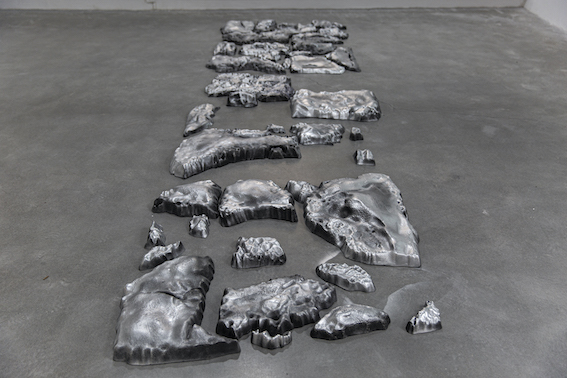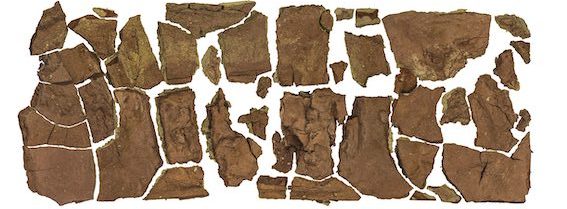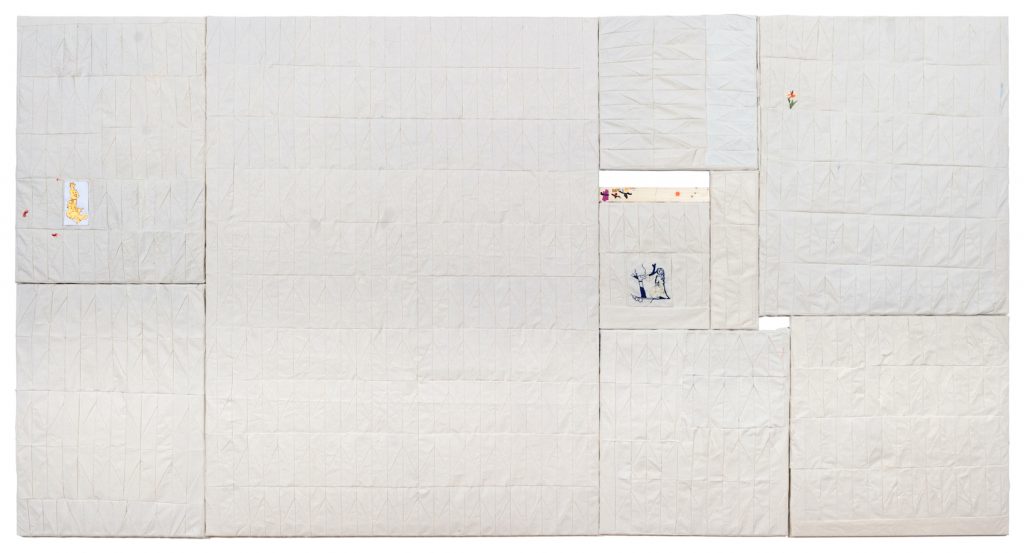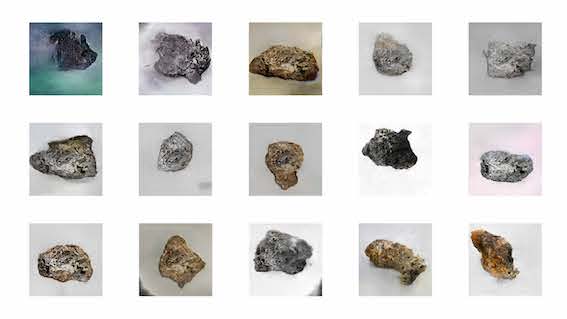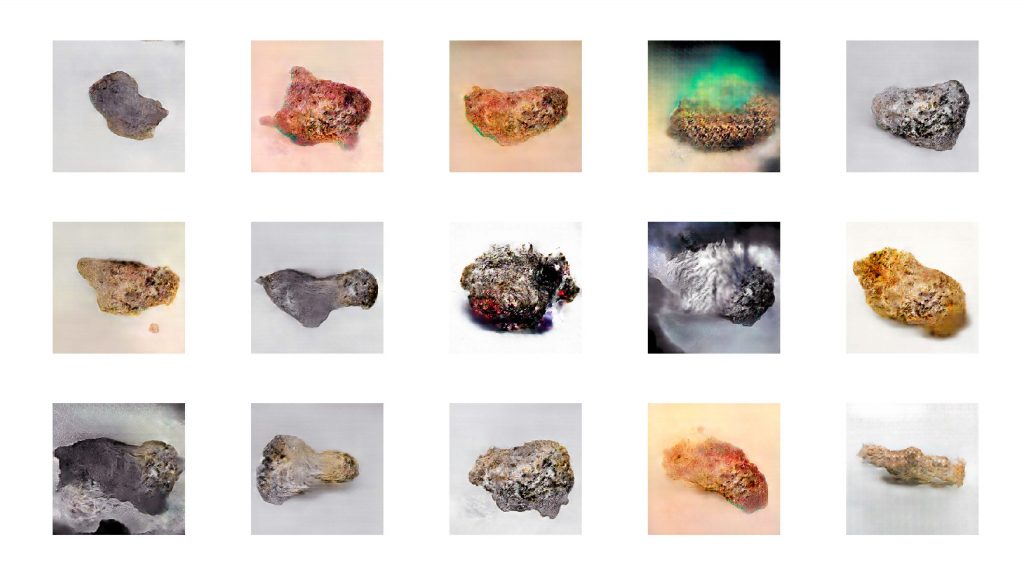FUTUREPROOF – a Dialogue on the Future and Speculation
feat. Desiree Ding, Mark Gens, Judith Kisner, Ben Nurgenç, Thomas Pfeffer und Pranjal Trivedi, Curator: Anthi Argyriou
on show 19 November 2021 – 30 January 2022 (closed)
The virtual exhibition of the project group by the same name at galerie postel has now been terminated. The blog page will stay online for the public to consult and we will be happy to answer questions concerning exhibition and artists, please do not hesitate to contact us via email or telephone!
Please click on the video to watch the recording of the digital opening as of 19 November 2021. To visit the exhibition, please click the virtual gallery space below or read the blog further down the page with additional information on the works exhibited. Have a pleasant stay!
Desiree Ding
please click here for artist’s biography of Desiree Ding
Clay as a material has a long tradition in China, usually connected abroad with the idea of „white gold“ and „fine bone china“. Desiree Ding however for her works , in which the clay undergoes a destructive process of drying, cracking and dissolving in water, and a transformation process of digitalisation and printing, on red and more yellowish clay that on can get in NY.
Why this material? Why digitalise it? The answer can be found in an early work displaying a photo of a group of clay-built houses that have been transformed into print and dissolved in a video displayed at FUTUREPROOF: Their form and colour refer to the traditional housing in some areas of New York,where Desiree Ding, Ben Nurgenç and Mark Gens met – which finally led to the FUTUREPROOF project. Dissolved in water the house cannot be completely reconstructed, just like the memory, that dissolves with time never to be flawlessly reconstructed again.
Memory, its reconstruction and preservation of objects are the starting point and core of many of Dings’ works. Moving back to China confronted the artist working in large scale installation art with the challenge of the transport. Instead of numbering everything consecutively, she digitalised works that were fragile or too big to take them with her. Back in China she printed the work – on paper and at a larger scale in aluminium. The grey colour irritates as the form is reminiscent of a dried river bed. But even more – the material qualities have changed completely with the surface of the aluminium protecting the sculpture from corrosion and are all but fragile.
Changing from fragile instability to immateriality and finally immorality gives a somehow religious sutext to the work that corresponds with the treatment of another sculpture: When placing the broken fragments of the earthy clay piece on top of the shiny glaze of basin used for ink painting, Ding uses the process to perform the process as a quasi-religous rite. The outcome not only documents the process, it forms an image of abstract qualities with the glossy shine contrasting at a maximum with the powdery substance of the clay that both together are part of Desiree Dings search for memory, special places and cultural connexion investigated in Dings’ works.
credits by order of appearance:
DESIREE DING 痕迹 vestige, 2020, 325×125 cm, aluminum cast
DESIREE DING specimen, 2020, 17 x 10 cm, clay, ink, ceramic
DESIREE DING 记忆 Memo, 2016, 125 x 325 cm, digital print on aluminum
DESIREE DING Capsule, 2016, digital video
prices are given in the 3D exhibition space and available on request, please do not hesitate to contact us: kontakt (at) galeriepostel.de
Mark Gens
please click here for biographical details on Mark Gens
It is an ever-present flood of images that forms our perception of the past, the present – and therefore the future. Social media has not invented this idea but has contributed to the speed of the torrent that sweeps the internet and our visual world.
Mark Gens collects these images. The vast archive he set up consists of images from more than 7 years of search on google, photographs taken by the artists himself and stills from films and documentaries. They are organized, assembled, reused, transferred from work to work and transformed in and into collages.
When layered and assembled, these images enter into a dialogue. As signifiers of the cultural context of the viewer they add their own historic and present meaning to each other, accumulating their symbolic weight. An effect that can be applied as well to the exhibition situation where a number of works accumulate in groups on the wall, reinforcing each other’s meaning.
Balancing his presentation on a thin line between emotion and documentation, Gens attempts to trigger an emotional response in the viewer.
Mark Gens’s specific research interest lies with the question of violence and the dominance of some beings over others. Images of tools of force keep turning up, helicopters, airplanes and truncheons are confronted with nakedness, robotics and wilderness – depicting the hunter rather than the hunted.
The use of the printed image facilitates multiplication and the re-arrangement and re-use of material. But there is more to his choice of material: The use of grommets for hanging has an anarchic feel to it, allowing for quick re-arrangement and rejection of the highly finished look of the traditional picture frame and glass.
The pasting of paper on walls – in this instance on sheetrock blocks – stems from the context of illegal wheat pasting in public spaces and contextualizes the images with methods of political protest. A nod to protest art is also found in the colour drained printed black, white, blue and red tonality of the images.
Mark Gens’s works provoke reflection on society, on structures and hierarchies and pose the question: Amidst all the technological progress, has humankind remained essentially the same – a violent, atavistic crowd?
credits by order of appearance:
MARK GENS Coyote, 2021, 33 x 33 cm (h x w) Inkjet print on sheetrock
MARK GENS Buoy, 2021, 33 x 33 cm (h x w) Inkjet print on sheetrock
MARK GENS No. 5, 2021, 48 x 33 cm (h x w), Cyanotype, Inkjet, Mixed media
MARK GENS No. 6, 2021, 48 x 33 cm (h x w), Cyanotype, Inkjet, Mixed media
MARK GENS No. 3, 2021, 48 x 33 cm (h x w), Cyanotype, Inkjet, Mixed media
prices are given in the 3D exhibition space and available on request, please do not hesitate to contact us: kontakt (at) galeriepostel.de
Judith Kisner
please click here for biographical details on Judith Kisner
Judith Kisner’s approach to art is probably the most analogue one of the FUTUREPROOF members. In her works, she reflects on painting as a medium – its material aspects, the technique, the duration of the painting process, its physical presence and its art historical and painterly reception
The polyptich shown above has been manufactured. Its structure consists of canvas elements formed like wedges as they are used for stretcher frames. With the open fissures with hanging threads they stress their own materiality. As does the piece of wood that is covered with spillage of acrylic paint and emphasises the absence of colour on the canvas.
Goddesses are embroidered on the canvas – the Norn Verdandi, the Edda’s goddess of fate responsable for everything emerging, and the Greek goddess of discord, Eres, who triggered the trojan wars by throwing the golden apple. Differently to altar-related polyptichs, the elements of Kisner’s work can be independently rearranged and are thereby adaptable to any spacial context.
The iconographical approach is typical also for a significant number Kisner’s other works, in which she relates to works by other artists. Painted in translucent layerings of brilliant colours and vivid brushstrokes the paintings work as often ironising comments on paintings important to Kisner executed by other artists.
The black painting for the FUTUREPROOF exhibition, however, are a product of Kisners occupation with the text that has been a sort of initial starting point for the FUTUREPROOF-group, Adolfo Bioy Casares‘ „The invention of Morel“ of 1940. This dystopy describes a world, in which a character stranded on an island by accident, notices, that everyone he meets, are just a recording of their former existence.
Here, too, Kisner employs historic research that she processes and transforms into her paintings, in this instance of paintings with a dominant presence of black and a dismal appearance. In this way, the abstract paintings are also consistant with Kisner’s preoccupation with her genre: A comment on the painterly process and its reception.
credits by order of appearance:
JUDITH KISNER Oh my goddess Verdandi, 2021, canvas, embroidery, wood, 318 × 165 cm
JUDITH KISNER untitled, (1-4) 2021, 30 x 24 cm (h x w) acrylic on canvas
prices are given in the 3D exhibition space and available on request, please do not hesitate to contact us: kontakt (at) galeriepostel.de
Ben Nurgenç
For biographical details on Ben Nurgenç, please click this link
Ben Nurgenç is a teamplayer. In collaboration with an algorith developed by Shahd Safarani and him and with the support of funghi he builds his „sculptures“. The ai does the first move: It offers images generated by the algorithm. Nurgenç selects these images, forms the sculptures according to the images given and has the funghi grow into forms he sets up for them.
Different concepts of time meet (or clash): Automatised ai that applies changes at a non-human speed and develops a vast number of new images in a short time, the human hand, that, probably emotionally induced, modifies the form, and the funghi, with their slow organic growth rate.
In Nurgenç’s working process coincidence, emotion and the predictable behaviour of ai that produces only seemingly intelligently automations of art predetermined by the algorithm, meet. The organic forms of funghi do not obey the artist or any algorithm but develop their own live, structures and colours. All to the different effect of the materials of funghi, clay (burned and raw) and transparent 3d prints.
Many dys- and utopias have been written, describing the potential end of the world. To Ben Nurgenç ai is no threat, but part of a collaboration, that does not act outside a human and organic sphere of influence, all to a potentially open outcome.
Ben Nurgenç’s works are an experimental setup for a collaboration on a future where ai, human beings and nature will have to find a common mode to co-exist to arrive at an outcome bearable for all.
credits by order of appearance:
BEN NURGENÇ & SHAHD SAFARANI untitled, selection of 3, 2020, 512 x 512 px, Generative adversarial Network
BEN NURGENÇ 16/10.2.47, 2021, 11 x 4,5 x 4,5 cm, mushroom mycelium
BEN NURGENÇ 16/10.2.32, 2021, 9,5 x 4,5 x 4 cm, PLA (Polylactic acid)
BEN NURGENÇ 16/10.2.16, 2021, 8 x 5 x 5 cm, plaster
BEN NURGENÇ 16/10.2.14, 2021 6 x 3 x 3 cm, Plaster, Pigment
prices are given in the 3D exhibition space and available on request, please do not hesitate to contact us: kontakt (at) galeriepostel.de
Thomas Pfeffer
Please click here for the biography of Thomas Pfeffer
credits by order of appearance:
THOMAS PFEFFER, algorithmic video, 2021
THOMAS PFEFFER AS3.1, 2021, 39.8 x 70 cm (h x w) algorithmic / digital c print
THOMAS PFEFFER clutter#3, 2021, 42 x 60 cm (h x w) algorithmic / digital c print
prices are given in the 3D exhibition space and available on request, please do not hesitate to contact us: kontakt (at) galeriepostel.de
Pranjal Trivedi
For information on biographical details of Pranjal Trivedi, please follow this link
Explanation given by Pranjal Trivedi:
Changes inform our perception of time as well as our imagination of the future.
This short animation juxtaposes representations of cosmic turbulence and geological fluctuations with human-induced climate change. What does it mean to conceive or even proof any future in this age – a search for an inflection amidst the rising tide of our turbulent fate, or a requiem for tipping towards oblivion?
‘Triptych in Time’ consists of three consecutive animations that depict cosmic turbulent flow and decay when the Universe had reached an early tipping point in its history, known as recombination. The cosmic matter flow in blue (above) and magnetic flow in red (below) are separated by an evolving boundary. The shapes traced out by the boundary depict geological, then historic, and finally recent anthropogenic changes to the Earth’s climate, in that order. They are also a reflection of our liminal and fragile station in an unfolding Universe.
Methods & Background Information
The background animations are adaptations from data produced by cosmological computer simulations. These simulations were originally produced by the author with collaborators [1], to understand the evolution of magnetised cosmic material by solving the non-linear fluid equations.
The simulated time period spans the recombination era of the early Universe, when its age was 0.1-10 million years, or less than 0.1% of its current age. This era is when hydrogen atoms first formed and the entire Universe underwent a tipping point or a transition, from being originally opaque to becoming transparent to light, creating the cosmic background radiation. The animations are chosen to show the velocity (blue upper panel) and magnetic field (red lower panel) of the cosmic material (fluid) as it begins to flow and then develops turbulence which finally decays.
The animated boundary curves separating the upper and lower panels are adapted from publicly available observational data measuring the concentration of carbon dioxide in the Earth’s atmosphere. The first boundary represents the geological fluctuations over ice-ages in the period from 800,000 years ago to the present [2] and the second represents the historical industrial period from 1700 AD to the present [3], both obtained from analyses of Antarctic ice-core data. The third boundary curve represents the recent human impact from 1958 to the present, recorded at the Mauna Loa Observatory, Hawaii, popularly known as the ‘Keeling Curve’ [4].
Sources of Scientific Data
1. Trivedi P., Reppin J., Chluba J., Banerjee R., 2018, Magnetic heating across the cosmological recombination era: results from 3D MHD simulations, Monthly Notices of the Royal Astronomical Society, 481, 340
2. Lüthi, D., Le Floch, M., Bereiter, B. et al. High-resolution carbon dioxide concentration record 650,000–800,000years before present. Nature 453, 379–382 (2008)
3. Macfarling Meure, C. et al., 2006: Law Dome CO2, CH4 and N2O ice core records extended to 2000 years BP. Geophysical Research Letters, 33.
4. Scripps CO2 Program, UC San Diego & C. D. Keeling, et al. Atmospheric CO2 and 13CO2 exchange with the terrestrial biosphere and oceans from 1978 to 2000: observations and carbon cycle implications, pages 83-113, in „A History of Atmospheric CO2 and its effects on
Plants, Animals, and Ecosystems“, editors, Ehleringer, J.R., T. E. Cerling, M. D. Dearing, Springer Verlag, New York, 2005.
PRANJAL TRIVEDI Triptych in Time, 2021, simulation / digital video 2:01 min.
prices are given in the 3D exhibition space and available on request, please do not hesitate to contact us: kontakt (at) galeriepostel.de
[/spb_text_block] [spb_blank_spacer height=“30px“ width=“1/1″ el_position=“first last“] [spb_text_block animation=“none“ animation_delay=“0″ simplified_controls=“yes“ custom_css_percentage=“no“ padding_vertical=“0″ padding_horizontal=“0″ margin_vertical=“0″ custom_css=“margin-top: 0px;margin-bottom: 0px;“ border_size=“0″ border_styling_global=“default“ width=“1/1″ el_position=“first last“]
Please click here for more details on curator Anthi Argyriou
FUTUREPROOF is supported by the Ministry of Culture and Media, Hamburg, the Hamburg Cultural Foundation and the Claussen-Simon-Foundation


